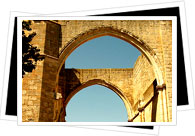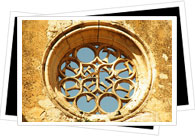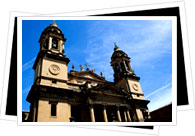After years of Roman, Visigothic and Moorish rule, Spain's first "Christian" style of architecture was called Romanesque. Romanesque architecture hit Spain in the 10th and 11th centuries out of a need for religious buildings in which to practice the newfound freedom to worship as they pleased. Without any models to go by, Romanesque architecture was a somewhat rudimentary style characterized by thick stone walls, squat appearances and very little natural light due to narrow windows. Other typical features include perfect semicircular arches, barrel vaults and little decoration.
While the region of Navarra has several remaining Romanesque churches and buildings, the city of Pamplona does not. What it does have, however, is transition architecture from the early Gothic stage, which naturally began with a transition period from Romanesque to Gothic.
 While Romanesque buildings were squat and bulky, Gothic architecture sought to achieve open space, thinner walls, greater heights and more natural light. Pointed arches and vaults took over their semicircular counterparts, and buttresses - exterior supports - were integrated to compensate for the thin walls and larger windows. Large stained windows are a key Gothic feature, both for aesthetic and practical purposes: they are both beautiful and let in natural light.
While Romanesque buildings were squat and bulky, Gothic architecture sought to achieve open space, thinner walls, greater heights and more natural light. Pointed arches and vaults took over their semicircular counterparts, and buttresses - exterior supports - were integrated to compensate for the thin walls and larger windows. Large stained windows are a key Gothic feature, both for aesthetic and practical purposes: they are both beautiful and let in natural light.
As a predominantly medieval city, Pamplona preserves numerous fine examples of Gothic architecture. The churches of San Cernin and San Nicolás are interesting cases. Built around the turn of the 13th century, the two churches have sturdy appearances with thick walls and small windows. This was partly because it was still the early years of the Gothic style and it was still transitioning from Romanesque; however, it's also because they were both built to double as forts, as the districts of San Cernin and San Nicolás were bitter - and violent - rivals. In fact, the two churches even have watchtowers.
 Another impressive example of Pamplona's Gothic architecture is the 13th century Cámara de los Comptos, the city's only surviving example of civilian Gothic architecture. Like the churches of San Cernin and San Nicolás, many of the building's features are typical of the transition period from Romanesque to Gothic. The building is sturdy and with thick stone walls, still minimal decoration and a mix of semi-circular and pointed arches, vaults and windows.
Another impressive example of Pamplona's Gothic architecture is the 13th century Cámara de los Comptos, the city's only surviving example of civilian Gothic architecture. Like the churches of San Cernin and San Nicolás, many of the building's features are typical of the transition period from Romanesque to Gothic. The building is sturdy and with thick stone walls, still minimal decoration and a mix of semi-circular and pointed arches, vaults and windows.
A final example of Pamplona's excellent Gothic architecture is the city's breathtakingly beautiful cathedral, the Catedral de Santa María. This "new" cathedral was built, starting in the 14th century, on the site of the city's 12th century Romanesque cathedral. From the outside, the cathedral is fairly unimpressive, thanks to the Neoclassical façade that was added in the 18th century. What awaits you once you pass through the main door, however, is a whole different story.
 Beautiful Gothic features impress the eye, such as ribbed vaults, beautiful stained glass windows and the overall impression of height and space. The Cathedral's most impressive feature is perhaps its elegant, French Gothic-style cloister, whose construction began in the 13th century. Considered one of the world's most beautiful Gothic cloisters, it features elaborate adornment, elegant tracery and dozens of towering pointed arches set around a small garden. Other magnificent Gothic parts of the Catedral de Santa María include the Capilla Barbazana and the Refectory and Kitchen, which hold the Museo Diocesano.
Beautiful Gothic features impress the eye, such as ribbed vaults, beautiful stained glass windows and the overall impression of height and space. The Cathedral's most impressive feature is perhaps its elegant, French Gothic-style cloister, whose construction began in the 13th century. Considered one of the world's most beautiful Gothic cloisters, it features elaborate adornment, elegant tracery and dozens of towering pointed arches set around a small garden. Other magnificent Gothic parts of the Catedral de Santa María include the Capilla Barbazana and the Refectory and Kitchen, which hold the Museo Diocesano.